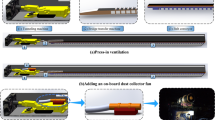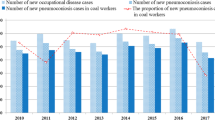Abstract
In order to investigate the diffuse pollution mechanisms of high-concentration dusts in the blasting driving face, the airflow-dust coupled model was constructed based on CFD-DEM coupled model; the diffusion rules of the dusts with different diameters at microscopic scale were analyzed in combination with the field measured results. The simulation results demonstrate that single-exhaust ventilation exhibited more favorable dust suppression performance than single-forced ventilation. Under single-exhaust ventilation condition, the motion trajectories of the dusts with the diameter smaller than 20 μm were close to the airflow streamline and these dusts were mainly distributed near the footway walls; by contrast, under single-forced ventilation condition, the motion trajectories of the dust particles with a diameter range of 20~40 μm were close to the airflow streamlines, and a large number of dusts with the diameter smaller than 20 μm accumulated in the regions 5 m and 17~25 m away from the head-on section. Moreover, under the single-exhaust ventilation, the relationship between dust diameter D and negative-pressured-induced dust emission ratio P can be expressed as P = − 25.03ln(D) + 110.39, and the dust emission ratio was up to 74.36% for 7-μm dusts, and the path-dependent settling behaviors of the dusts mainly occurred around the head-on section; under single-forced ventilation condition, the z value of the dusts with the diameter over 20 μm decreased and the dusts with a diameter smaller than 7 μm are particularly harmful to human health, but their settling ratios were below 22.36%.

The airflow-dust CFD-DEM coupling model was established. The numerical simulation results were verified. The migration laws of airflow field were obtained in a blasting driving face. The diffusion laws of dusts were obtained after blasting.






















Similar content being viewed by others
References
Akbarzadeh V, Hrymak AN (2016) Coupled CFD-DEM of particle-laden flows in a turning flow with a moving wall. Comput Chem Eng 86:184–191
Akhshik S, Behzad M, Rajabi M (2015) CFD–DEM approach to investigate the effect of drill pipe rotation on cuttings transport behavior. J Pet Sci Eng 127:229–244
Amritkar A, Deb S, Tafti D (2014) Efficient parallel CFD-DEM simulations using OpenMP. Academic Press Professional, Inc, Cambridge
Chen M, Hu Y, Lu W et al (2011) Numerical simulation of blasting excavation induced damage to deep tunnel. Rock Soil Mech 32:1531–1537
Chen J, Wang Y, Jiang Z (2013) Numerical simulation of blasting dust concentration distribution and diffusion regularities in stope. J China Coal Soc 38:147–152(6)
Chen J, Wang Y, Li X et al (2015) Erosion prediction of liquid-particle two-phase flow in pipeline elbows via CFD–DEM coupling method. Powder Technol 275:182–187
Erol I, Aydin H, Didari V, Ural S (2013) Pneumoconiosis and quartz content of respirable dusts in the coal mines in Zonguldak, Turkey. Int J Coal Geol 116–117:26–35
Fan T, Zhou G, Wang J (2018) Preparation and characterization of a wetting-agglomeration-based hybrid coal dust suppressant. Process Saf Environ Prot 113:282–291
Feng Y, Owen D (2014) Discrete element modelling of large scale particle systems—I: exact scaling laws. Comput Part Mech 1:159–168
Goldasteh I, Ahmadi G, Ferro AR (2013) Monte Carlo simulation of micron size spherical particle removal and resuspension from substrate under fluid flows. J Aerosol Sci 66:62–71
Habeeb L (2013) ANSYS 13.0 help, FLUENT theory guide
Han Q, Yang N, Zhu J, Liu M (2015) Onset velocity of circulating fluidization and particle residence time distribution: a CFD-DEM study. Particuology 21:187–195
Hertz H (1880) On the contact of elastic solids 92:
Hu S, Wang Z, Feng G (2015) Temporal and spatial distribution of respirable dust after blasting of coal roadway driving faces: a case study. Fortschr Mineral 5:679–692
Hu S, Feng G, Ren X et al (2016) Numerical study of gas–solid two-phase flow in a coal roadway after blasting. Adv Powder Technol 27:1607–1617
Ji Y, Ren T, Peter W et al (2016) A comparative study of dust control practices in Chinese and Australian longwall coal mines. Int J Min Sci Technol 26:199–208
Jiang Z, Chen M, Chen J (2013) Numerical simulation of dust concentration distribution and changing regularities in roadway stope blasting. J Cent South Univ 44:1190–1196
Kim S, Jeong W, Jeong D, Seok J (2006) Numerical simulation of blasting at tunnel contour hole in jointe rock mass. Tunn Undergr Space Technol Inc Trenchless Technol Res 21:306–307
Korevaar MW, Padding JT, Van Der Hoef MA, Kuipers JAM (2014) Integrated DEM–CFD modeling of the contact charging of pneumatically conveyed powders. Powder Technol 258:144–156
Kurnia JC et al (2014) Dust dispersion and management in underground mining faces. Int J Min Sci Technol 24:39–44
Nakayama S, Uchino K, Inoue M (1996) 3 dimensional flow measurement at heading face and application of CFD. Shigen-to-Sozai 112:638–644
Nie W, Cheng WM, Bin YY et al (2012) The research and application on whole-rock mechanized excavation face of pressure ventilation air curtain closed dust removal system. J China Coal Soc 37:1165–1170(6)
Nie W, Liu Y, Wei X, Hu X et al (2016a) Effect of suppressing dust by multi-direction whirling air curtain on fully mechanized mining face. Int J Min Sci Technol 26:629–635
Nie W, Ma X, Cheng W et al (2016b) A novel spraying/negative-pressure secondary dust suppression device used in fully mechanized mining face: a case study. Process Saf Environ Prot 103:126–135
Pandey SK, Tripathi BD, Mishra VK (2008) Dust deposition in a sub-tropical opencast coalmine area, India. J Environ Manag 86:132–138
Petrov T, Wala AM, Huang G (2014) Parametric study of airflow separation phenomenon at face area during deep cut continuous mining. Min Technol 122:208–214
Qin YP, Zhang MM, Cui LJ, Liu JY (2011) Numerical simulation of dust migration and study on dust removal modes with the forced ventilation shunt in a fully mechanized workface. J Univ Sci Technol Beijing 33:790–794
Ren YH, Qin YP (2013) Study on contraction of dust control system in continuous coal mining. Adv Mater Res 734-737:824–827
Ren T, Wang Z, Cooper G (2014) CFD modelling of ventilation and dust flow behaviour above an underground bin and the design of an innovative dust mitigation system. Tunn Undergr Space Technol 41:241–254
Sa Z, Li F, Qin B, Pan X (2012) Numerical simulation study of dust concentration distribution regularity in cavern stope. Saf Sci 50:857–860
Shao T, Yinyu HU, Wang W et al (2013) Simulation of solid suspension in a stirred tank using CFD-DEM coupled approach. Chin J Chem Eng 21:1069–1081
Toraño J, Torno S, Menéndez M, Gent M (2011) Auxiliary ventilation in mining roadways driven with roadheaders: validated CFD modelling of dust behaviour. Tunn Undergr Space Technol Inc Trenchless Technol Res 26:201–210
Tsuji Y, Tanaka T, Ishida T (1992) Lagrangian numerical simulation of plug flow of cohesionless particles in a horizontal pipe. Powder Technol 71:239–250
Wang (2011) Numerical simulation of dust distribution at a fully mechanized face under the isolation effect of an air curtain. Int J Min Sci Technol 21:65–69
Wang Z, Ren T (2013) Investigation of airflow and respirable dust flow behaviour above an underground bin. Powder Technol 250:103–114
Wang H, Wang D, Tang Y, Wang Q (2015a) Foaming agent self-suction properties of a jet-type foam preparation device used in mine dust suppression. Process Saf Environ Prot 98:231–238
Wang Y, Luo G, Geng F et al (2015b) Numerical study on dust movement and dust distribution for hybrid ventilation system in a laneway of coal mine. J Loss Prev Process Ind 36:146–157
Xie Y, Fan G, Dai J et al (2007) New respirable dust suppression systems for coal mines. Int J Min Sci Technol 17:321–325
Zheng Y, Feng C, Jing G et al (2009) A statistical analysis of coal mine accidents caused by coal dust explosions in China. J Loss Prev Process Ind 22:528–532
Zhou G, Qiu H, Zhang Q et al (2016a) Experimental investigation of coal dust wettability based on surface contact angle. J Chem 2016:1–8
Zhou G, Zhang Q, Bai R, Ni G (2016b) Characterization of coal micro-pore structure and simulation on the seepage rules of low-pressure water based on CT scanning data. Fortschr Mineral 6:78
Zhou G, Zhang Q, Bai R et al (2017) The diffusion behavior law of respirable dust at fully mechanized caving face in coal mine: CFD numerical simulation and engineering application[J]. Process Saf Environ Prot 106:117–128
Acknowledgements
This work was financially supported by State Key Program of National Natural Science of China (Grant No. U1261205), the Outstanding Youth Fund Project of Provincial Universities in Shandong Province (Grant No. ZR2017JL026), the Key Research and Development Program of Shandong Province (Grant No. 2016GSF120002), the Qingdao City Science and Technology Project (Grant No. 16-6-2-52-nsh), and Sub Project of National Key Research and Development Program (Grant No. 2017YFC0805202).
Author information
Authors and Affiliations
Corresponding author
Additional information
Responsible editor: Marcus Schulz
Rights and permissions
About this article
Cite this article
Yu, H., Cheng, W., Xie, Y. et al. Micro-scale pollution mechanism of dust diffusion in a blasting driving face based on CFD-DEM coupled model. Environ Sci Pollut Res 25, 21768–21788 (2018). https://doi.org/10.1007/s11356-018-1992-4
Received:
Accepted:
Published:
Issue Date:
DOI: https://doi.org/10.1007/s11356-018-1992-4




